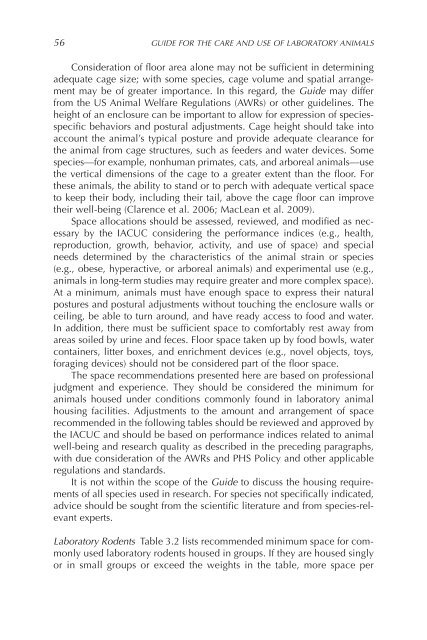Guide for the Care and Use of Laboratory Animals - Office of ...
Guide for the Care and Use of Laboratory Animals - Office of ...
Guide for the Care and Use of Laboratory Animals - Office of ...
- No tags were found...
Create successful ePaper yourself
Turn your PDF publications into a flip-book with our unique Google optimized e-Paper software.
56GUIdE FOR ThE CARE ANd USE OF LAbORATORy ANIMALSConsideration <strong>of</strong> floor area alone may not be sufficient in determiningadequate cage size; with some species, cage volume <strong>and</strong> spatial arrangementmay be <strong>of</strong> greater importance. In this regard, <strong>the</strong> <strong>Guide</strong> may differfrom <strong>the</strong> US Animal Welfare Regulations (AWRs) or o<strong>the</strong>r guidelines. Theheight <strong>of</strong> an enclosure can be important to allow <strong>for</strong> expression <strong>of</strong> speciesspecificbehaviors <strong>and</strong> postural adjustments. Cage height should take intoaccount <strong>the</strong> animal’s typical posture <strong>and</strong> provide adequate clearance <strong>for</strong><strong>the</strong> animal from cage structures, such as feeders <strong>and</strong> water devices. Somespecies—<strong>for</strong> example, nonhuman primates, cats, <strong>and</strong> arboreal animals—use<strong>the</strong> vertical dimensions <strong>of</strong> <strong>the</strong> cage to a greater extent than <strong>the</strong> floor. For<strong>the</strong>se animals, <strong>the</strong> ability to st<strong>and</strong> or to perch with adequate vertical spaceto keep <strong>the</strong>ir body, including <strong>the</strong>ir tail, above <strong>the</strong> cage floor can improve<strong>the</strong>ir well-being (Clarence et al. 2006; MacLean et al. 2009).Space allocations should be assessed, reviewed, <strong>and</strong> modified as necessaryby <strong>the</strong> IACUC considering <strong>the</strong> per<strong>for</strong>mance indices (e.g., health,reproduction, growth, behavior, activity, <strong>and</strong> use <strong>of</strong> space) <strong>and</strong> specialneeds determined by <strong>the</strong> characteristics <strong>of</strong> <strong>the</strong> animal strain or species(e.g., obese, hyperactive, or arboreal animals) <strong>and</strong> experimental use (e.g.,animals in long-term studies may require greater <strong>and</strong> more complex space).At a minimum, animals must have enough space to express <strong>the</strong>ir naturalpostures <strong>and</strong> postural adjustments without touching <strong>the</strong> enclosure walls orceiling, be able to turn around, <strong>and</strong> have ready access to food <strong>and</strong> water.In addition, <strong>the</strong>re must be sufficient space to com<strong>for</strong>tably rest away fromareas soiled by urine <strong>and</strong> feces. Floor space taken up by food bowls, watercontainers, litter boxes, <strong>and</strong> enrichment devices (e.g., novel objects, toys,<strong>for</strong>aging devices) should not be considered part <strong>of</strong> <strong>the</strong> floor space.The space recommendations presented here are based on pr<strong>of</strong>essionaljudgment <strong>and</strong> experience. They should be considered <strong>the</strong> minimum <strong>for</strong>animals housed under conditions commonly found in laboratory animalhousing facilities. Adjustments to <strong>the</strong> amount <strong>and</strong> arrangement <strong>of</strong> spacerecommended in <strong>the</strong> following tables should be reviewed <strong>and</strong> approved by<strong>the</strong> IACUC <strong>and</strong> should be based on per<strong>for</strong>mance indices related to animalwell-being <strong>and</strong> research quality as described in <strong>the</strong> preceding paragraphs,with due consideration <strong>of</strong> <strong>the</strong> AWRs <strong>and</strong> PHS Policy <strong>and</strong> o<strong>the</strong>r applicableregulations <strong>and</strong> st<strong>and</strong>ards.It is not within <strong>the</strong> scope <strong>of</strong> <strong>the</strong> <strong>Guide</strong> to discuss <strong>the</strong> housing requirements<strong>of</strong> all species used in research. For species not specifically indicated,advice should be sought from <strong>the</strong> scientific literature <strong>and</strong> from species-relevantexperts.<strong>Laboratory</strong> Rodents Table 3.2 lists recommended minimum space <strong>for</strong> commonlyused laboratory rodents housed in groups. If <strong>the</strong>y are housed singlyor in small groups or exceed <strong>the</strong> weights in <strong>the</strong> table, more space per
















